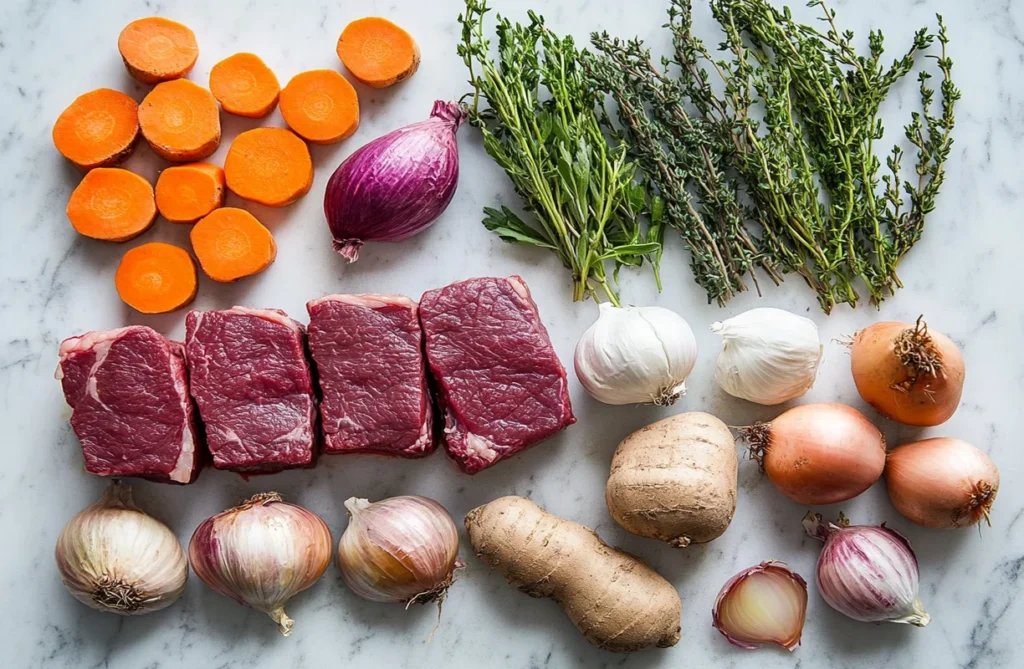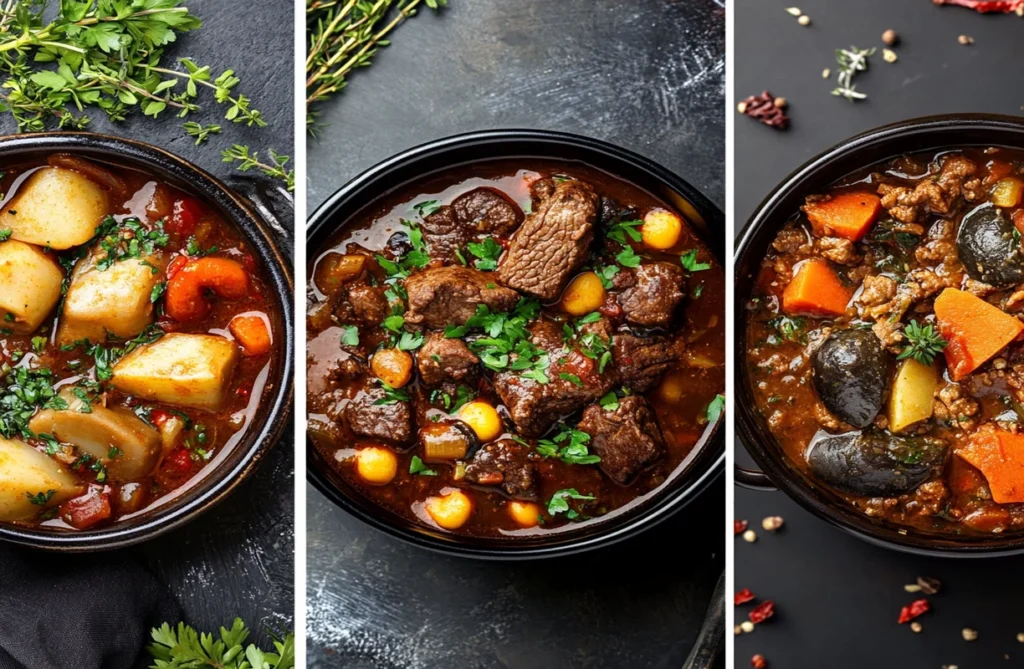Stew. Just the word alone makes you feel warm and cozy, doesn’t it? It’s the kind of dish that feels like a hug in a bowl, especially on a chilly evening. But let’s be real—not all stews are created equal. Some are watery, some are bland, and others leave you wondering why you even bothered. So, what’s the secret to good stew? Is it the ingredients? The cooking time? The love you pour into it? Spoiler alert: it’s all of the above, and a little more.
In this article, we’re diving deep into the world of stews. We’ll explore the history, the basics, and the little tricks that can turn your stew from “meh” to “mind-blowing.” Whether you’re a seasoned chef or a kitchen newbie, by the end of this, you’ll be armed with everything you need to make the perfect stew. So, grab your apron, and let’s get started!

The History of Stew: A Timeless Comfort Food
Did you know stew has been around for centuries? Yep, it’s not just your grandma’s recipe—it’s a dish that’s stood the test of time. Stew dates back to ancient times when people would throw whatever ingredients they had into a pot and let it simmer over a fire. It was practical, hearty, and, most importantly, delicious.
Fast forward to today, and stew has become a global phenomenon. From French boeuf bourguignon to Moroccan tagine, every culture has its own take on this classic dish. But no matter where you go, the essence of stew remains the same: it’s about bringing people together over a pot of something warm and comforting.
As food historian Margaret Visser once said, “Stew is not just a dish; it’s a tradition, a ritual, and a way of life.” And honestly, isn’t that what makes it so special?
Why Stew is a Go-To Dish for Every Season
You might think stew is just a winter thing, but let me stop you right there. Stew is for every season, and here’s why.
The Versatility of Stew
Stew is like a blank canvas—you can make it with whatever you have on hand. Got some leftover veggies? Toss them in. Craving something spicy? Add a dash of chili powder. The possibilities are endless, and that’s what makes it so versatile.
Nutritional Benefits of Stew
Let’s not forget how nutritious stew can be. Packed with protein, fiber, and vitamins, it’s a one-pot wonder that’s as good for your body as it is for your soul. Plus, the slow cooking process helps retain the nutrients, making it a healthier option compared to frying or grilling.
The Secret to Good Stew: Breaking Down the Basics
Alright, let’s get to the juicy part—what makes a stew truly great? It all comes down to three things: ingredients, technique, and patience.
Choosing the Right Ingredients
The foundation of any good stew is, of course, the ingredients. But here’s the thing: not all ingredients are created equal. For the best results, opt for fresh, high-quality produce and meats.
- Meat: Tough cuts like chuck roast, brisket, or lamb shoulder are ideal because they become tender and flavorful when cooked low and slow.
- Vegetables: Root veggies like carrots, potatoes, and parsnips hold up well during long cooking times.
- Liquid: Broth, wine, or even beer can add depth and richness to your stew.
The Importance of Fresh vs. Frozen Ingredients
Now, I know what you’re thinking—can I use frozen veggies? The answer is yes, but with a caveat. Fresh ingredients will always give you the best flavor, but frozen ones can work in a pinch. Just make sure to adjust the cooking time, as frozen veggies tend to release more water.
The Role of Herbs and Spices in Stew
Herbs and spices are the unsung heroes of stew. They add layers of flavor that can take your dish from ordinary to extraordinary. Think bay leaves, thyme, rosemary, and a pinch of paprika. Don’t be afraid to experiment and find your perfect blend.

The Cooking Process: Slow and Steady Wins the Race
Here’s where the magic happens. Stew isn’t something you can rush—it’s a labor of love. Why Collagen is Your Secret Weapon
Tough cuts like chuck or brisket thrive in stews because they’re rich in collagen. During slow cooking, collagen breaks into gelatin, creating:
- Silky-smooth meat: melts in your mouth.
- Luxurious broth: Adds body without thickeners.
Pro Tip: Cook below a simmer (180–200°F / 82–93°C) for 2-3 hours—the sweet spot for collagen transformation.
Flavor Layering: Build a Flavor Foundation
- Sear Meat: Develop Maillard reaction (browned crust = deep flavor).
- Sauté Aromatics: Onions, garlic, celery—cook until golden.
- Deglaze: Use wine, beer, or broth to lift browned bits (fond) from the pot.
Julia Child’s Wisdom:
“The only time to eat diet food is while you’re waiting for the stew to heat up.”
Troubleshooting Common Stew Problems
| Issue | Quick Fix | Prevention Tip |
|---|---|---|
| Watery Stew | 1 tbsp cornstarch + 2 tbsp cold water | Simmer uncovered last 30 mins |
| Tough Meat | Extend cook time by 1 hour | Use collagen-rich cuts (avoid lean!) |
| Bland Flavor | Add soy sauce + splash of vinegar | Layer spices early; taste every 30 mins |
Global Stew Variations
1. French Beef Bourguignon
Signature Twist: Red wine (Burgundy), pearl onions, bacon.
Pro Hack: Replace ½ broth with beef bone broth for extra collagen.
2. Hungarian Goulash
Signature Twist: Smoked paprika, caraway seeds, sour cream finish.
Fun Fact: Traditionally cooked over open fire in a bogrács (cauldron).
3. Moroccan Tagine
Signature Twist: Apricots, chickpeas, preserved lemon.
Serve With: Couscous + harissa drizzle.
Vegetarian & Vegan Stew Mastery
Hearty Plant-Based Bases
- Umami Bomb: Combine soy sauce + nutritional yeast + porcini powder.
- Creaminess: coconut milk or blended cashews.
Protein Hacks
| Ingredient | Texture | Flavor Pairing |
|---|---|---|
| Lentils | Meaty, firm | Smoked paprika + cumin |
| Jackfruit | Shredded, tender | BBQ sauce + liquid smoke |
| Tempeh | Chewy, nutty | Tamari + maple syrup |
Perfect Pairings: What to Serve with Stew
Bread Reinvented
- Irish Soda Bread soaks up broth beautifully.
- Garlic Naan: Ideal for Moroccan or Indian-inspired stews.
Unexpected Sides
Pickled veggies: Bright acidity cuts through richness (try quick-pickled radishes!).
Polenta: The creamy texture balances spicy stews.

Storing and Reheating Stew
Stew often tastes better the next day, but proper storage is key.
How to Store Stew
Let the stew cool completely before transferring it to airtight containers. It can last up to 3 days in the fridge or 3 months in the freezer.
Reheating Stew Without Losing Flavor
Reheat stew on the stovetop over low heat, adding a splash of broth if it’s too thick. Avoid microwaving, as it can affect the texture.
FAQs
Q: What can I add to my stew to make it taste better?
A: Elevate your stew with these flavor boosters:
- Umami Power: Soy sauce, fish sauce, tomato paste, or dried mushrooms.
- Acid: A splash of red wine, balsamic vinegar, or lemon juice to brighten richness.
- Herbs/Spices: Bay leaves (remove before serving!), smoked paprika, or fresh thyme.
- Sweetness: A teaspoon of honey or pomegranate molasses for balance.
- Fresh Finish: Stir in parsley, cilantro, or gremolata after cooking.
Pro Tip: Add ingredients in layers—sauté aromatics first, acid mid-way, and delicate herbs last.
Q: What is the secret ingredient in a stew?
A: Acid! A dash of vinegar, wine, or citrus:
- Tenderizes meat by breaking down collagen.
- Balances fatty or heavy flavors.
- Adds depth without overpowering.
Unexpected Twist: Try pickle brine (for tang) or coffee (for earthy bitterness).
Q: What not to put in a stew?
A: Avoid these common mistakes:
- Lean Meats (e.g., sirloin): They turn tough. Use collagen-rich cuts like chuck or short ribs.
- Delicate Veggies Too Early (zucchini, peas): Add in the last 20 minutes to prevent mush.
- Overcrowding the Pot: Leads to steaming, not searing. Cook in batches!
- Raw Flour: Creates a chalky texture. Dust meat with flour before searing instead.

Final Thoughts: The Secret to Good Stew is in Your Hands
At the end of the day, the secret to good stew lies in your hands. It’s about the care you put into selecting ingredients, the patience you show during cooking, and the joy you feel when sharing it with others. So, grab your pot, gather your ingredients, and start cooking. The secret to good stew is waiting for you to discover it.